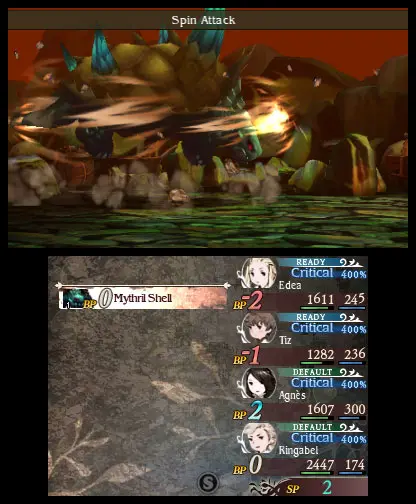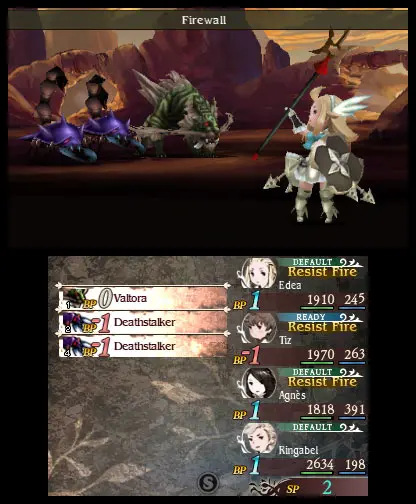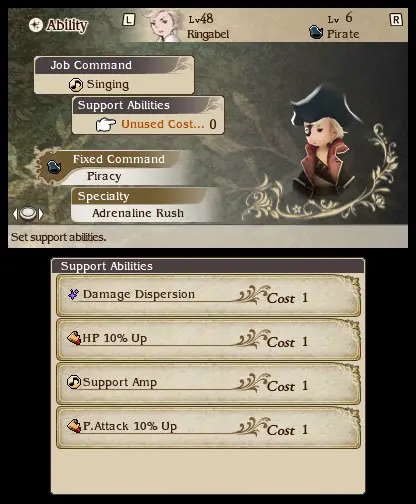 Let me cut right to the chase: Bravely Default is a Final Fantasy game with a different name. I could waste words alluding to this fact, but when it all comes down to it this is a true, honest-to-god Final Fantasy game.
Let me cut right to the chase: Bravely Default is a Final Fantasy game with a different name. I could waste words alluding to this fact, but when it all comes down to it this is a true, honest-to-god Final Fantasy game.
SquareEnix has called Bravely Default a “spiritual successor” to the 2010 DS game, Final Fantasy: The 4 Heroes of Light, which obviously was grouped into the FF subset of JRPGs. Why SquareEnix shied away from using the standard “Final Fantasy” title here is beyond me, as Bravely Default is also the best Final Fantasy game to hit shelves almost seven years.
Bravely Default, for the Nintendo 3DS, is a turn-based Japanese Role Playing Game that takes its name from a gimmick in the battle system. During combat, players can opt to “default” their attacks, which saves them up (up to four total) and then allows them to unleash a massive barrage of damage in one round. While in default mode, the player has higher defense, which is an added bonus if you’re saving up attacks.

“Bravely,” on the other hand, is when the player essentially uses up to four attacks in one turn without saving them up first. The caveat here is that the player cannot do anything again for up to four turns (depending on how many “bravelys” you use), which means lower defense and the inability to heal or debuff. In other words, you’d have to be brave to put it all on the line. See what they did there?
Aside from the gimmick, which is very welcome, combat runs just like any other standard Final Fantasy game. Characters can choose from a pool of over 20 different job classes–as they collect them during play–and each job has their own strengths and weaknesses, and abilities learned in each job can be held onto to create hybrid characters, such as a white magic wielding ninja, or a two-handed sword using summoner.
The story of Bravely Default centers around a war between the Crystal Orthodoxy–a religious sect that worships and protects the crystals of the elements–and the Eternian Empire (which is the plot of the majority of the single-digit-numbered Final Fantasy games). There are four large crystals–each representing one of the four elements: fire, water, air, and earth–and the crystals have become corrupt, which has caused a calamity to occur, and the village of Norende was sucked into the eart and lost forever. The only survivor of Norende is a young man named Tiz, who was tending the herd when the ground opened up. He watched from afar as his world ended and witnessed first hand his younger brother falling into the abyss.

Lost and alone, Tiz stumbles across Agnes, the Vestal–or guardian–of the Wind Crystal. They quickly join up with Edea, an Eternian Sky Knight whose father is also a high-ranking official in the Eternian Empire, and lastly, an amnesiac named Ringabel (seriously) joins the group. Ringabel is a sex-starved pervert who wants to sleep with anything that has breasts and is driven in life by what’s in his pants. These four heroes come together and cleanse each crystal to restore light and balance back to the world at large. They also have an airship/boat, because this is a Final Fantasy game in all but name, and all Final Fantasy games have airships.
Bravely Default offers some very interesting social interactions and side quests. Tiz can rebuild Norende, which opens up a asynchronous mini-game that uses collected StreetPass players as town citizens, and the player can direct these citizens to rebuild and grown the town and it’s various shops. The shops in turn open up new items for purchase in the main campaign, and certain parts and effects can also be unlocked.
StreetPass also introduces large monsters, called Nemeses, to the town, and the player can choose to fight them for large bounties and XP and even share them with others via StreetPass. SquareEnix has been generous with SpotPassing some really cool monsters to battle, but most are very high level (some as high as 99), so fighting them is never a walk in the park.

Any friends in your friend list that are playing can be added to your adventure and be called upon during battle for assistance. This is essentially the summon spells of Bravely Default. There is a cool summoning animation and then the character who calls the friend gets a special overpowered move. There is a feature called Abilink where a friend’s learned abilities can be borrowed and linked your characters on a more permanent basis. If you are a friendless gamer, no worries, as Bravely Default will seek out a small army of players from around the world via the internet for you to use. You can check in once per day, via the Internet for new players, villagers and bounties.
In addition to StreetPass and SpotPass functionality, Bravely Default also has micro-transactions for special potions that bypass the ill effects of going bravely during battle. The potions can be earned for free as one is given for every eight hours that the Nintendo 3DS is in sleep mode with the game booted up. Up to three of these potion can be held at once, but if you don’t have the patience, the potions can be purchased via the Nintendo eShop for real currency.

Bravely Default is a gorgeous game to look at. The backgrounds are all hand drawn and the character designs are from Akihiko Yoshida, who was a designer on Ogre Tactics and most Final Fantasy games, and their spinoffs/sequels. Yoshida utilizes that cutesy “Precious Moments” style, and then dresses the female characters in leggy high stockings and low cut, cleavage-bearing tops. It’s a strange mix but works for this game. And the costume designs in Japan were far more risque.
The voice acting, which runs through about 85% of the game, is well done, but the writing suffers from the need to make it sound medieval/Tolkien-like. Even after a voiced cut scene, there is a party chat feature that is text only, and usually centers around using a game feature. It does nothing for the story, and can be skipped.
Another great addition is in the ability to customize the entire gaming experience. If the battles are too hard, you can adjust the game’s difficulty. If you are injured and have a long way to go to get to an inn, you can adjust the frequency of the random encounters. On the flip side, if you are grinding, you can ramp it up to where each step is a new battle. I have only used these features a handful of times on my almost 40 hours of playing–in both scenarios I just mentioned–but knowing that they are there is welcome.

Last, but not least is the music. While it doesn’t have the iconic fanfares of the Final Fantasy series during and after battle, Bravely Default has a tune of its own and the world themes are fully orchestrated masterpieces by Revo, who also fronts a band called Sound Horizon who specializes in fantasy music. It is spectacular in every way and this is one aspect where this game may actually exceed the game series I’ve been comparing it to throughout this entire review.
Bravely Default is a throwback JRPG with a ton of new elements and social features. It’s classic is every way to the games that shaped the genre, and it even still forges ahead with new and exciting features. The series is destined to become a franchise in itself and one that will have a huge following, as this is one of the best JRPGS I’ve played in over a decade. It’s easy in this day and age to throw out the old adage, “they sure don’t make them like they used to,” but here, SquareEnix has done just that.
With so much to do, including a ton of in-game side quests and the collecting of all the different jobs, and with announced DLC additions to come, this game can go on and on. Also Bravely Default has multiple endings, which all but ensures it a semi-permanent spot in my 3DS for many months to come. And no matter what name it goes by, a great game is still a great game and this is a great game.
Bravely Default was purchased at retail for this review. It was released on February 7, 2014 exclusively for Nintendo 3DS.
Shop for Bravely Default at Amazon.com or purchase it digitally from the Nintendo eShop.



